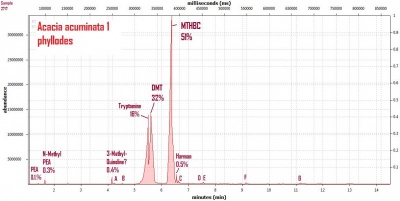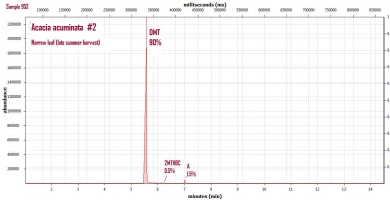Difference between revisions of "Acacia acuminata"
(→Suppliers) |
(→Alkaloid content) |
||
| Line 100: | Line 100: | ||
Broad-leafed form gave 0.72% total alkaloid and narrow-leafed form gave 1.5% total alkaloid. Both collected Oct. White 1957 <ref>[http://www.accurateinformationmedia.com/library/TroutsNotes/SomeSimpleTryptamines_2ndEd_2007_with_addendum.pdf</ref> | Broad-leafed form gave 0.72% total alkaloid and narrow-leafed form gave 1.5% total alkaloid. Both collected Oct. White 1957 <ref>[http://www.accurateinformationmedia.com/library/TroutsNotes/SomeSimpleTryptamines_2ndEd_2007_with_addendum.pdf</ref> | ||
| + | |||
| + | |||
| + | |||
| + | [[File:TLC_Acuminata(broad_phyllode_var).jpg|400px]] | ||
| + | [[File:AcuminataAL.jpg|390px]] | ||
== Other uses == | == Other uses == | ||
Revision as of 11:24, 1 May 2014
Contents
General Plant Info
Acacia acuminata, commonly known as the raspberry jam tree, fine leaf jam, "raspberry jam" or jam tree, is a native shrub of South West of Western Australia, which grows slowly to about a height of 5m, though they have been know to grow to heights of 10m plus..
The species name acuminata comes from the Latin acuminatus, which means pointed or elongated. This refers to the long point at the end of each leaf. The common name "raspberry jam" refers to the strong odour of freshly cut wood, which resembles raspberry jam.
As with most Acacia species, it has phyllodes rather than true leaves. These are plurinerved and bright green, around ten centimetres long and about two millimetres wide, and finish in a long point. The lemon yellow flowers are held in tight cylindrical clusters about two centimetres long. The pods are light brown and flattened, about ten centimetres long and five millimetres wide.
Acacia acuminata is comprises of 5 main variants: [Maslin et al. (1999)]
A. acuminata (small seed variant)
A. acuminata (narrow phyllode variant)
A. acuminata (broad phyllode variant / typical variant)
A. acuminata (acuminata/burkittii variant 1)
A. acuminata (acuminata/burkittii variant 2)
Bark (all variants) is longitudinally fissured on main stems (especially near base), smooth on upper branches, and grey.
The unusual sap colouring is caused by carotene dissolved in oil held in wood pores.
Geographic distribution
Endemic to Western Australia, it occurs throughout the south west of the State. It is common in the Wheatbelt, and also extends into the semi-arid interior.
Subsp. acuminata occurs in the South west of Western Australia extending south from near the Murchison River to Borden and Ravensthorpe and east to Yalgoo, Kalgoorlie and Balladonia.
Subsp. burkittii extends east from the distribution of subsp. acuminata, through inland South Australia to the western plains of New South Wales.
Beard’s Provinces: Eremaean Province, South-West Province.
IBRA Regions: Avon Wheatbelt, Coolgardie, Esperance Plains, Geraldton Sandplains, Great Victoria Desert, Jarrah Forest, Mallee, Murchison, Nullarbor, Swan Coastal Plain, Yalgoo.
IBRA Subregions: Avon Wheatbelt P1, Avon Wheatbelt P2, Central band, Nullarbor Plain, Dandaragan Plateau, Eastern Goldfield, Eastern Mallee, Eastern Murchison, Edel, Fitzgerald, Geraldton Hills, Lesueur Sandplain, Mardabilla, Northern Jarrah Forest, Perth, Shield, Southern Cross, Southern Jarrah Forest, Tallering, Western Mallee.
Local Government Areas (LGAs): Albany, Beverley, Brookton, Broomehill-Tambellup, Bruce Rock, Carnamah, Chapman Valley, Chittering, Coolgardie, Coorow, Corrigin, Cuballing, Cue, Cunderdin, Dalwallinu, Dandaragan, Dowerin, Dumbleyung, Dundas, Esperance, Gnowangerup, Goomalling, Greater Geraldton, Irwin, Jerramungup, Kalgoorlie-Boulder, Katanning, Kellerberrin, Kent, Kojonup, Kondinin, Koorda, Kulin, Lake Grace, Menzies, Merredin, Mingenew, Moora, Morawa, Mount Marshall, Mukinbudin, Murchison, Narembeen, Narrogin, Northam, Northampton, Nungarin, Perenjori, Pingelly, Quairading, Ravensthorpe, Shark Bay, Subiaco, Tammin, Three Springs, Toodyay, Trayning, Victoria Plains, Wagin, West Arthur, Westonia, Wickepin, Williams, Wongan-Ballidu, Woodanilling, Wyalkatchem, Yalgoo, Yilgarn, York
Identification
Shrub or tree (2–) 3–7 (–10) m high. New shoots appressed yellow-hairy. Branchlets ascending to erect, rarely pendulous, glabrous.
Phyllodes linear to narrowly elliptic, apices curved-acuminate to caudate, (5–) 8–15 (–18) cm long, (1.5–) 2–8 (–10) mm wide, flat, straight to shallowly curved, ascending to erect or spreading at various angles, finely multistriate, green, glabrous except margins fringed with minute white hairs.
Inflorescences simple; spikes sessile, (7–) 10–30 mm long (when dry), golden. Flowers mostly 4-merous; calyx dissected 1/2 or more.
Pods linear, flat to variously raised over seeds, straight-edged to deeply constricted between seeds, (2–) 3–8 cm long, 2.5–7 mm wide, firmly chartaceous to thinly coriaceous-crustaceous.
Seeds longitudinal, mostly compressed, oblong to elliptic or ovate, 2–4.5 mm long, 1.5–3 mm wide, 1–2.5 mm thick, black, shiny to slightly shiny, dark brown to black; aril membranous, white or creamy white.
A. acuminata (small seed variant)
Pods 2.5–3 mm wide; seeds 2–3 mm long, <2 mm wide; compressed (1–1.5 mm thick); phyllodes (5–) 7–10 cm long, 3–6 mm wide, straight (Kalannie - near Yalgoo)
A. acuminata (narrow phyllode variant)
Pods 3–7 mm wide; seeds larger than above; phyllodes often >10 cm long
Seeds 3–4 mm long, 1.8–2.5 mm wide, compressed (1–1.5 mm thick) (Morawa SE to Balladonia)
Grows as a small rounded tree 2-5 m tall and 1.5-4 m wide. In ideal conditions it may grow to a height of 6-7 m and spreading about 7 m wide. Plants in open sites away from competition tend to have more rounded crowns than those in dense populations; with 2–6 main stems arising from ground level, sometimes with a single bole up to 0.5 (–1) m long, the main stems rather straight, slender and ascending to erect; crowns dense to mid-dense, rounded to sub-rounded, spreading and occupying 20–40% of the total plant height.
A. acuminata (typical variant)
Phyllodes mostly 4–8 mm wide and +/- straight to recurved; pods 4–7 mm wide
Seeds 2.3–3 mm wide, mostly compressed (1.8–2.5 mm thick) (Mingenew S to Borden & Ravensthorpe area)
Grows as a tall shrub or tree. In ideal conditions it may grow to a height of 10 m, but in most distributions is 3-7 m tall. Plants in open sites away from competition tend to have wider and more rounded crowns (to about 8 m across) than those from within closely spaced (about 1–3 m apart), often monospecific, populations; branchlets ascending to erect or rarely pendulous to sub-pendulous; few-branched at ground level (2–6 main stems) or with a single, straight to almost straight bole 0.3–1.5 (–2) m long and 10–30 (–45) cm dbh; crowns dense, rounded to sub-rounded and up to 7–8 (–10) m across.
A. acuminata (acuminata/burkittii variant 1)
Phyllodes mostly 2–3 mm wide and straight to shallowly incurved; pods 3–5 mm wide
Seeds slightly larger and more turgid than above (4–5 mm long, 2.5–3 mm wide, 1.5–2.5 mm thick) (Mullewa N to north of Murchison River)
A. acuminata (acuminata/burkitti variant 2)
Phyllodes mostly 4–8 mm wide and +/- straight to recurved; pods 4–7 mm wide
Seeds broader than above and clearly turgid (3.5–4 mm wide, 3–3.5 mm thick), globose (Eradu to Northampton and Ajana)
Alkaloid content
Jeremy (EGA 2009) reported DMT primary alkaloid. Recent net lore indicates 0.6-1.2% alkaloid dimethyltryptamine in leaves, 0.6-1.5% bark, with some ß-carbolines.
Broad-leafed form gave 0.72% total alkaloid and narrow-leafed form gave 1.5% total alkaloid. Both collected Oct. White 1957 [1]
Other uses
The wood is hard and durable, with an attractive, reddish, close grain. It has been used extensively for fence posts,[2] for ornamental articles, and for high-load applications such as sheave blocks. The wood's "air dried" density is 1040 kg/m³.[3] It is also being used as a companion/host tree with sandalwood (Santalum spicatum) plantations in the Wheatbelt region [4]
Timber is widely used in wood turning due to the beautiful grain and aroma of raspberry jam for some time after cutting.
Extraction
Cultivation
Acacia acuminata is easily grown in most temperate areas. Has high frost and drought tolerance with medium salt tolerance. It is suited to a range of soils including limestone provided it is reasonably free draining.
Flowers best in full sun. It requires at least 250mm/year (9.8in./year) average rainfall.[5]
They have a beautiful yellow flower and when this Acacia is in flower, the flowers absolutely cover the tree which makes for quite a spectacle.
Suppliers
- http://www.talbotnursery.com.au/plants/index.php?route=product/product&path=117_84&product_id=50
- http://herbalistics.com.au/shop/catalog/product_info.php?products_id=436
Links
- Template:APNI
- Template:Flora of Australia Online
- Template:FloraBase
- Template:Cite book
- Template:Cite book
- USDA GRIN
References
[A Biology of Acacias . T R New]
Cite error: <ref> tags exist, but no <references/> tag was found


